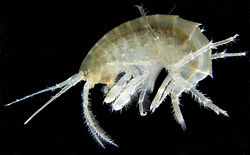Amphipoda
| Amphipoda | ||||||||||||
|---|---|---|---|---|---|---|---|---|---|---|---|---|
 A gammarid amphipod (Gammarus roeselii)
|
||||||||||||
| Scientific classification | ||||||||||||
|
||||||||||||
| Sub-orders | ||||||||||||
|
Gammaridea |
Amphipoda (amphipods) are an order of animals that includes over 7,000 described species of shrimp-like crustaceans ranging from 1 mm to 140 mm in length.
Most amphipods are marine; although a small number of species are limnic or terrestrial. Marine amphipods may be pelagic (living in the water column) or benthic (living on the ocean bottom). Pelagic amphipods are eaten by seabirds, fish, and marine mammals. Terrestrial amphipods such as sand fleas can often be seen amongst sand and pebbles or on beaches.
Distribution and life
Many species of pelagic amphipods are mutualistic or (usually) parasitic, living in association with jellyfish and salps. Phronima is a relatively common genus of pelagic amphipod that kills and cleans out the barrel-shaped body of a salp to live inside and raise its young.

Of the relatively few species of free-living, planktonic amphipods, the most abundant of all is Themisto gaudichaudii. Living in the Southern Ocean, this amphipod congregates in dense swarms, where it is a voracious predator of copepods and other small members of the zooplankton.
After copepods, krill and salps, which are mostly herbivorous, the carnivorous Themisto is the most abundant member of the mesozooplankton in the Southern Ocean.
In cold seas, benthic amphipods are enormously diverse and abundant. In the Southern Ocean, amphipods are the most abundant benthic crustaceans. Some are grazers, many are omnivorous, some even act as piranha-like scavengers, quickly cleaning the carcasses of dead tissue. Amphipods are one of the few animal groups frequently seen when submarines venture to the deepest parts of the oceans. Other benthic amphipods are the primary food of Gray Whales. Certain species of pelagic amphipods make vertical migrations diurnally.
A ship hull fouling species of amphipod common to Atlantic and estuarine waters is Jassa falcata.
External links
- Amphipoda fact sheet - Guide to the marine zooplankton of south eastern Australia
- Amphipod. Britannica (2008)
- Amphipoda page at www.crustacea.net includes a list of families
- The Amphipod Home Page
- A database of amphipod literature
- terrestrial amphipods on the UF / IFAS Featured Creatures Web site
- The Niphargus page All about the amphipod genus Niphargus